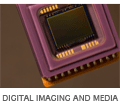Squid
Squid Development/Debug connector
Squid is a development system designed to allow full debug access to board that have a limited board real-estate/form factor. It does this through the use of a small 20 pin contact connector. This connector uses only 11mm x 9mm of board real-estate on the target board. Magnetics and transceivers for the Ethernet and RS232 serial are provided on the Squid main board, so these items need not be included on the target board.
The Squid system itself consists of two boards. One development board, housing the majority of the components, including all of the user-accessible external connectors, as well as power inputs/switches etc...
A second 'baby' Squid board, which contains the mating connector to be attached to the target board, and then an IDC-style socket for connecting back to the main Squid board.
The Squid development system provides the following features:
- JTAG
- 2-wire serial
- 4 differential wires, allowing for either
- Ethernet
- 2 x USB connectors (Host or Device)
- 2 x GPIO pins, which can be attached to either
- Switch (with optional pullup/pulldown)
- LED
- pin for external connectivity
- Optional capacitively connected to ground
- Up to 3 separate voltage lines for powering the target PCB. Each pin has a 500mA current rating.
- On-board PSU for powering the transceiver, LEDS & supplying 5v for the USB sockets. This is automatically generated from the VIN1-3 voltages supplied externally.
Pinout
Connector: Samtec FSI-110-10-L-AD
| Pin | Name | Description |
|---|---|---|
| Pin 1 | TPIP | Ethernet differential signal |
| Pin 2 | TPOP | Ethernet differential signal |
| Pin 3 | TPIM | Ethernet differential signal |
| Pin 4 | TPOM | Ethernet differential signal |
| Pin 5 | GND | Ground |
| Pin 6 | VIN0 | First Voltage line |
| Pin 7 | TMS | JTAG TMS signal |
| Pin 8 | TCK | JTAG TCK signal |
| Pin 9 | TDI | JTAG TDI signal |
| Pin 10 | TDO | JTAG TDO signal |
| Pin 11 | nSRST | JTAG nSRST signal (system resest) |
| Pin 12 | nTRST | JTAG nTRST signal (core reset) |
| Pin 13 | GND | Ground |
| Pin 14 | VIN1 | Second Voltage line |
| Pin 15 | GPA | GPIO A |
| Pin 16 | GPB | GPIO B |
| Pin 17 | GND | Ground |
| Pin 18 | VIN2 | Third Voltage line |
| Pin 19 | RXD | Serial receive line (input to the board being debugged) |
| Pin 20 | TXD | Serial transmit line (onput to the board being debugged) |
Advantages
- Small form factor connector, which can be fitted to almost any board.
We have used this connector on heavily packed boards as small as 70mmx40mm - Provides full debug access on even full form-factor production units
- No BOM cost to production units
- Provides standard robust connectors
- Quick-change connector to allow production to move between boards faster - less connectors to plug/unplug
Bluewater Systems Usage
We have used this module on a variety of boards with much success. As shown in this image, the connector can fit into even a very tightly packed board.










